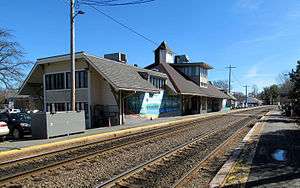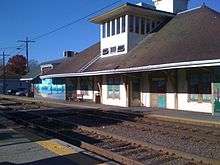Concord station (Massachusetts)
Concord Depot is a commuter rail station on the MBTA Commuter Rail Fitchburg Line at 90 Thoreau Street in downtown Concord, Massachusetts. As well as providing commuter service to Boston, the station offers tourists access to the various popular historic sites in Concord. It has two side platforms, which are low-level and not handicapped accessible, serving the line's two tracks. Although the station is within walking distance of the most heavily populated area of Concord, a small number of free parking spots are also available.
Concord | |||||||||||
|---|---|---|---|---|---|---|---|---|---|---|---|
 Concord station in March 2016 | |||||||||||
| Location | 90 Thoreau Street, Concord, Massachusetts | ||||||||||
| Coordinates | 42°27′25.73″N 71°21′28.98″W | ||||||||||
| Owned by | Town of Concord | ||||||||||
| Line(s) | Fitchburg Main Line | ||||||||||
| Platforms | 2 side platforms | ||||||||||
| Tracks | 2 | ||||||||||
| Construction | |||||||||||
| Parking | 86 spaces (free) 2 accessible spaces | ||||||||||
| Bicycle facilities | 10 spaces | ||||||||||
| Other information | |||||||||||
| Fare zone | 5 | ||||||||||
| Traffic | |||||||||||
| Passengers (2018) | 367 (weekday average boardings)[1] | ||||||||||
| Services | |||||||||||
| |||||||||||
History

Fitchburg Railroad service from Concord to Boston began in June 1844, and has continued since.[2] Although the Fitchburg Line went through a series of contractions due to funding issues in the 1960s and 1970s, service to Concord was never interrupted.[3]
The current station building was built in the Queen Anne style in the 1890s, replacing the wooden station from 1844. The new station was damaged by fire in 1895 and substantially rebuilt. When built, it was a squat hip-roofed station similar to other stations on the line. A control tower on the trackside roof was added later.[4]
The depot was later modified to during the 20th century and scarcely resembles the original. The trackside doors and windows have been boarded over, replaced by a mural painted in the early 1980s. Large side wings have been added, and the building converted for retail use. The circa-1907 express office is present just to the west and also in retail use; a freight house east of the station was demolished in 1991.[4]
References
- Central Transportation Planning Staff (2019). "2018 Commuter Rail Counts". Massachusetts Bay Transportation Authority.
- Karr, Ronald Dale (1995). The Rail Lines of Southern New England. Branch Line Press. p. 201. ISBN 0942147022.
- Belcher, Jonathan. "Changes to Transit Service in the MBTA district" (PDF). NETransit.
- Roy, John H. Jr. (2007). A Field Guide to Southern New England Railroad Depots and Freight Houses. Branch Line Press. pp. 142–143. ISBN 9780942147087.
External links
- MBTA - Concord

- Station from Sudbury Road from Google Maps Street View
- Station from Thoreau Street from Google Maps Street View